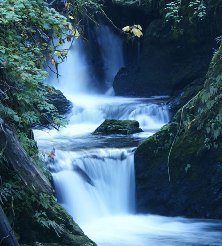AUTHORS
Amelia Nuding1 and Stephanie Hampton1,2
1 - National Center for Ecological Analysis & Synthesis, University of California, Santa Barbara, Santa Barbara, CA 93101-3351
2 - Corresponding Author: Stephanie Hampton (hampton@nceas.ucsb.edu)
THE ECOLOGICAL QUESTION
How does nutrient pollution impact stream ecosystems locally and nationally?
ECOLOGICAL CONTENT
Organic nutrients, land cover, biological indicators, macroinvertebrate index, stream ecosystem structure and function
WHAT STUDENTS DO
- Explore maps of streams and land use in the US
- Analyze national water quality data sets from the US Environmental Protection Agency at regional and national scales
- Perform basic calculations from data set and generate graphs
- Relate water quality with land use
- Relate water quality with stream ecology
SKILLS
Navigating and manipulating large data sets, reading metadata (descriptions of the data), creating graphs, connecting the analysis of data to scientific concepts
- What students should learn from this lesson: Students should understand the connections between land use and water quality, the effects of nutrient pollution, how bioindicators are useful to ecologists, and how to plot and interpret stream water quality and ecosystem integrity indicators.
- What skills students should acquire from this lesson: map interpretation, manipulation of datasets, construction and interpretation of box plots, simple linear regressions, log plots
STUDENT-ACTIVE APPROACHES
The questions posed throughout the activity are based on the six levels of Bloom’s taxonomy and critical thinking. The students are asked to generate hypotheses, and this can be done in pairs, for example as a “turn to your neighbor” exercise.
Students’ connection to this exercise will be enhanced if combined with hands-on activities such as fieldwork to collect macroinvertebrates and water samples in a stream, or laboratory work to measure water quality parameters.
ASSESSABLE OUTCOMES
The activity is designed as a series of investigations and questions which require students to summarize raw data, create charts and plots, and interpret maps and figures. The deliverables are: graphs generated by students, short answers to provided questions, and a short essay which synthesizes the concepts presented in this exercise. Prediction, analysis and synthesis are the core elements of the deliverables. In addition, pre- and post-test questions can be administered to uncover what lessons were really learned by students in this activity.
TRANSFERABILITY
This exercise is designed for college biology majors and non-majors, as well as students in a basic statistics class. Navigating, interpreting, and analyzing large data sets require basic skills that are applicable across all professional fields, from marketing to the hard sciences, and working with spreadsheets is necessary in many jobs and in studies that may be encountered from high school through post-graduate positions. This exercise may also be appropriate for pre-college students, though perhaps with some alterations to the lesson. It is designed to be appropriate for students with basic math and computer skills, and the analysis of the data can be made more or less complex at the instructor's discretion. Because this data set covers virtually all regions across the contiguous US, the lesson is also designed to examine trends in the state/region of the academic institution, allowing students and instructors to create a stronger connection between the national scope of this work and the local environment experienced by students.
The URLs included were live at the time of publication; in most cases, URLs will change over time and so we have uploaded static data and maps that may be readily used in this exercise and supplemented with new internet resources at the instructor’s discretion.
SOURCES
- U.S. Environmental Protection Agency. 2010. Wadeable streams assessment.
(http://www.epa.gov/owow/streamsurvey/pdf/WSA_Assessment_May2007.pdf) Accessed March 10, 2012. (Note this is a larger document that takes extra time to load.) - U.S. Environmental Protection Agency.2010. Probabilistic sampling databrowser.
(http://www.epa.gov/bioiweb1/statprimer/ProbabilisticSampling/index.html) Accessed March 10, 2012. -
U.S. Environmental Protection Agency. 2010. Teacher ‘use case’ for the national WSA browser.
(http://www.epa.gov/bioindicators/statprimer/WSAUseCaseTeacher.html) Accessed March 10, 2012. - U.S. Geological Survey. 2010. MRLC consortium viewer.
(http://gisdata.usgs.net/website/MRLC/viewer.htm) Accessed March 10, 2012. Note that you will need to find the key for this map separately – e.g., for Land Cover. -
U.S. Geological Survey. 2012. The National Land Cover Database.
(http://pubs.usgs.gov/fs/2012/3020) Accessed March 10, 2012. -
National Atlas. 2010. National atlas map maker.
(http://nationalatlas.gov/mapmaker) Accessed August 17, 2010. -
National Atlas. 2010. Map layer info: streams and water bodies.
(http://www.nationalatlas.gov/mld/hydrogm.html). Accessed March 10, 2012. -
U.S. Geological Survey 2010. The Gulf of Mexico hypoxic zone.
(http://toxics.usgs.gov/hypoxia/hypoxic_zone.html). Accessed March 10, 2012.
DOWNLOADS
- Full Article Text [doc], [pdf]
- Student Data: Contains wadeable stream assessment data [xls]
- Faculty Data: Contains wadeable stream assessment data with analysis [xls]
- Pre-test/post-test questions for student assessment [docx]
- Supplement 1: National Land Cover Data (NLCD) in the US [pdf]
- Supplement 2: Map of EPA regions [pdf]
- Supplement 3: Mean nutrient values in each EPA region [pdf]
- Supplement 4: Nutrient ecoregions and EPA’s nutrient criteria [pdf]
Description of Excel Files:
Description of other Resource Files:
ACKNOWLEDGMENTS
CITATION
Amelia Nuding and Stephanie Hampton. March 2012, posting date. Investigating human impacts on stream ecology: locally and nationallyTeaching Issues and Experiments in Ecology, Vol. 8: Practice #1 [online]. http://tiee.esa.org/vol/v8/issues/data_sets/nuding/abstract.html
